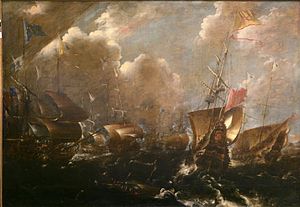Battle of Getaria
| Battle of Getaria | |||||||
|---|---|---|---|---|---|---|---|
| Part of the Franco-Spanish War (1635) | |||||||
 The Battle of Guetaria, by Andries van Eertvelt |
|||||||
|
|||||||
| Belligerents | |||||||
|
|
|
||||||
| Commanders and leaders | |||||||
|
Claude de Launay-Razilly |
|
||||||
| Strength | |||||||
| 27-44 ships 7-8 fireships |
12-18 galleons | ||||||
| Casualties and losses | |||||||
| No ship lost. 40 dead. | All galleons destroyed, except one. 4,000 – 5,000 dead. | ||||||
The Battle of Getaria or the Battle of Guetaria are the names given to a battle in the Franco-Spanish War (1635–59), which took place on 22 August 1638 at Getaria, northern Spain, when a French fleet under de Sourdis attacked and destroyed a Spanish fleet under Lope de Hoces.
In June 1638 a large French army crossed the Pyrenees to besiege Fuenterrabía. The French army was accompanied by a fleet between 27 and 44 French warships under Henri de Sourdis, who had to stop any help reaching Fuenterrabia over the sea.
De Hoces was ordered to attack the French fleet, but had only 12 galleons and some smaller ships at his disposal. The Spanish fleet sailed into the harbor of Getaria on 17 August and took up defensive positions close to the shore. This had several advantages: The largest French ships could not approach because of the shallow waters, the usual French tactics of close combat followed by boarding was impossible and the Spanish fleet had supporting fire from the shore.
De Sourdis decided to first batter the Spanish fleet with his superior fire power, then send in his fireships and cut off any escape route with his smaller vessels.
But first the wind had to blow towards the shore, which happened on 22 August. The French plan works extremely well. De Hoces had made no precautions against fireships, because this weapon was normally not used by the French, and de Sourdis had his fireships disguised as normal war vessels. The entire Spanish fleet caught fire, except the Santiago. Only 1,000 Spanish survivors reached the shores alive, including Lope de Hoces.
Chevalier Paul distinguished himself during this action.
The battle was a first important victory for the new French navy built under Cardinal Richelieu, who was very excited and thankful towards the French commanders.
The victory gave the French temporary naval control of the Bay of Biscay.
Despite this naval victory, the French effort at the Siege of Fuenterrabía (1638) was a failure for the combined French sea and land forces, which had to withdraw on 8 September, only 3 weeks after the victory at sea.
...
Wikipedia
